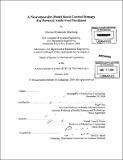A neuromuscular-model based control strategy for powered ankle-foot prostheses
Author(s)
Eilenberg, Michael Frederick
DownloadFull printable version (8.042Mb)
Other Contributors
Massachusetts Institute of Technology. Dept. of Mechanical Engineering.
Advisor
Hugh Herr.
Terms of use
Metadata
Show full item recordAbstract
In the development of a powered ankle-foot prosthesis, it is desirable to provide the prosthesis with the ability to exhibit human-like dynamics. A simple method for achieving this goal involves trajectory tracking, where a specific target torque trajectory is known, and the controller issues commands to follow the trajectory as closely as possible. However, without a methodology to update the desired trajectory in real time, this type of control scheme is limited in that it cannot adapt to externally-applied disturbances. Adaptation is critical in the field of prosthetics. A prosthesis must be able to adjust to variable terrain and respond to changes in behavior of the wearer. In this thesis, we hypothesize that a powered ankle-foot prosthesis that is controlled using a positive-force- feedback reflex of a Hill-type posterior leg muscle will exhibit biologically-consistent adaptive changes in stance phase behavior across terrain. To evaluate this hypothesis, a controller for a powered ankle-foot prosthesis is advanced that comprises a neuromuscular model consisting of a single, effective plantar flexor muscle with positive force feedback and an effective dorsiflexor consisting of a proportional-derivative impedance controller. Selected parameters of this hybrid controller were optimized to best match the torque-angle relationship of an intact, biological ankle from a weight and height-matched individual with intact limbs. The torque-tracking capabilities of the electromechanical system were evaluated, and a control system was developed to enable the prosthesis to produce human-like ankle mechanics. Clinical trials were performed on a healthy, bilateral amputee study participant at two separate level-ground walking speeds, as well as for ramp ascent and descent walking at self-selected speeds. The neuromuscular reflex model, when used as the basis of the prosthetic controller during these trials, produced ankle torques in qualitative agreement with values from the weight and height-matched individual with intact limbs. This agreement included an impedance modulation in the initial stance period, as well as a biologically consistent trend of increasing prosthesis net work for correspondingly increasing floor inclinations.
Description
Thesis (S.M.)--Massachusetts Institute of Technology, Dept. of Mechanical Engineering, 2009. Cataloged from PDF version of thesis. Includes bibliographical references (p. 89-90).
Date issued
2009Department
Massachusetts Institute of Technology. Department of Mechanical EngineeringPublisher
Massachusetts Institute of Technology
Keywords
Mechanical Engineering.